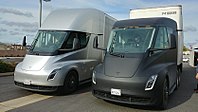
Photo from wikipedia
Abstract Technological advancement in portable electronic devices is often inhibited by the inadequate capacity of energy-storage devices. Asymmetric all-solid-state supercapacitors (ASSCs) can overcome energy-storage limitations of symmetric ASSCs by utilizing… Click to show full abstract
Abstract Technological advancement in portable electronic devices is often inhibited by the inadequate capacity of energy-storage devices. Asymmetric all-solid-state supercapacitors (ASSCs) can overcome energy-storage limitations of symmetric ASSCs by utilizing two different electrodes to extend the operating voltage window without decomposition of the electrolyte. Here, we report on the fabrication of carbon cloth (CC)/nickel hydroxide (Ni(OH)2) and CC/carbon nanotubes (CNTs) electrodes, consisting of conformal nanoparticles of Ni(OH)2 and nanostructured CNTs grown directly on the grooves and crests of carbon fibers, to provide additional active area for charge storage. The CC/Ni(OH)2 electrodes display an exceptional specific capacitance (Cs) of 3987 F g−1 and an areal capacitance (Ca) of 1248 mF cm−2, whereas the CC/CNTs electrodes exhibit a Cs of 928 F g−1 and Ca of 278 mF cm−2. Furthermore, the asymmetric ASSCs employing CC/Ni(OH)2 as an anode and CC/CNTs as a cathode, exhibit a Cs of 196 F g−1 at a cell potential of 1.8 V, yielding an energy density of 132.7 Wh kg−1. Moreover, the asymmetric ASSCs display improved low self-discharge behavior by charging it at an optimal current density and time. The results suggest that the asymmetric ASSCs are a low cost and efficient alternative in energy storage applications.
Journal Title: Journal of Alloys and Compounds
Year Published: 2020
Link to full text (if available)
Share on Social Media: Sign Up to like & get
recommendations!